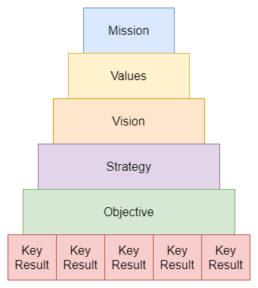Have you ever been pulled into a company-wide kickoff? You can tell the presentations are intended to get you excited for what you’ll be working to accomplish over the next twelve months. They present the company mission statement, which resonates with you and you’re jazzed to make this mission a reality. Then senior leadership reveals the objectives for the next twelve months and you’re stuck asking yourself, how do these objectives progress our business toward fulfilling our mission?
Background
Ok, let’s take a minute to examine what’s going on here.
Every business should have a hierarchy of company statements. This article from the Harvard Business Review does a great job describing why – it’s a bit dated but useful as a starting point. Below, I’ve placed OKRs where I feel they fit in the hierarchy.
The mission states why the business exists. Values are what the business believes in and how it will behave. Vision is what the business wants to be. The strategy is the competitive game plan made up of objectives. The most critical part about these statements is that they are tightly coupled together, and each lower level should advance the upper-levels.
I modified the hierarchy from the article to include OKRs instead of the scorecard. If you’re in technology, then there is a good chance that you’ve heard the term OKR over the past decade. Generally speaking, Objectives and Key Results (OKR) offer a simple framework to define and track objectives and measure progress.
OKRs are not a new concept Andrew Grove wrote about them in 1983. They’ve become popularized more recently through books like Inspired by Marty Cagan and Radical Focus by Christina Wodtke. It’s a great tool and something you should consider using if you’re struggling to execute your strategy.
Why it fails
I can hear the little voice in my head already, “Ok, Great! So, why should I care about all this MBA mumbo jumbo? This sounds like a lot of fluff.”
Here’s the thing, when your hierarchy of company statements tightly align with each other and have definitive measures of success, then you, the people you manage, and the entire company feel like they are working toward the same goal. If you believe in the Milton Friedman definition of capitalism, then these statements should revolve around revenue, profitability, and shareholder value. On the other hand, if you subscribe to the Adam Smith definition of capitalism, then the statements will revolve around customer value. If you want to know more about why the difference is important, check out what Simon Sinek has to say on the subject.
You fail to inspire and motive when your statements don’t align. If your mission and vision state that your company exists because it makes a profound impact on humanity, but your objectives focus on revenue, profitability, or shareholder value, then you’re not aligned. Your company will be hollow, and your people will feel uninspired, unmotivated, and empty. People who feel empty are less productive, which increases the risk of entering the organizational death spiral.
Related Posts
January 28, 2021
Set Up WordPress
October 15, 2018
Agile For The Win, A Wacky Real Life Example
August 27, 2018
Easy SAM Local Setup to Kickstart Projects
August 13, 2018
Unit Testing is The Hidden Key to Unlock Productivity
August 6, 2018
Authoritative Code Review Evidence
October 23, 2017
Defining DevOps
February 27, 2017
Backup Strategy
March 10, 2014
Turtle Beach PX51
November 20, 2013
TeamCity, Git, and Assembly Version Number
February 15, 2013
Using Trello
April 14, 2012











